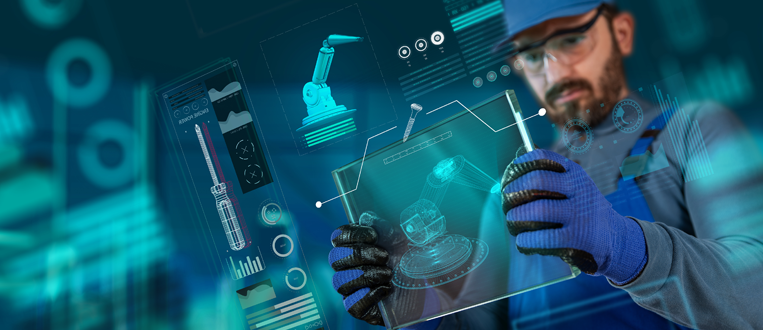Using artificial intelligence to improve non-ferrous foundry operations

Editor's Note: The following blog article was written by NFFS Executive Director Jerrod Weaver.
Introduction
In today's rapidly evolving non-ferrous foundry industry, embracing artificial intelligence (AI) can and should be a strategy to significantly improve plant efficiency, productivity, and product quality. This article will identify the benefits of using AI in non-ferrous foundries and summarize how they can be integrated into a modern manufacturing environment.
Understanding Non-ferrous Foundry Operations
Non-ferrous foundries specialize in casting metals like aluminum, copper, and zinc. These operations involve melting metals in furnaces, casting them into molds, and then completing the process through cooling, cleaning, and finishing. Non-ferrous foundries face various challenges, including maintaining consistent quality, optimizing resource utilization, ensuring safety, adhering to regulations, and adapting to changing customer demands.
The Potential of Artificial Intelligence in Foundries
At its core, AI enables machines to replicate human intelligence, including learning, reasoning, and problem-solving. AI has the potential to revolutionize non-ferrous foundry operations in several ways:
- Data-Driven Insights: AI can analyze extensive historical data to identify patterns, trends, and anomalies, enabling improved decision-making, optimization of casting parameters, and the prediction of equipment failures.
- Quality Enhancement: AI-driven systems employing computer vision and machine learning can detect defects in castings that might elude human inspectors. This results in higher-quality output, less waste, and compliance with stringent customer quality standards.
- Resource Allocation Optimization: Through AI-driven scheduling and planning tools, foundries can minimize downtime and reduce costs by efficiently allocating resources like personnel, equipment, and materials.

Leveraging AI for Efficiency
AI is a powerful tool for streamlining non-ferrous foundry operations and boosting efficiency:
- Predictive Maintenance: AI algorithms analyze data to predict potential equipment failures, allowing proactive maintenance to avoid unexpected downtime.
- Resource Allocation Optimization: AI-powered scheduling and planning tools reduce downtime, enhance operational efficiency, and minimize costs.
- Defect Reduction: AI-powered quality control systems identify defects, optimize casting parameters, and ensure consistent output, leading to higher-quality castings and higher yields.
Integrating AI technologies promises a more efficient and competitive non-ferrous foundry operation.
Enhancing Quality with AI
AI can significantly enhance the quality of castings by optimizing the casting process and reducing defects:
- Real-Time Monitoring: AI algorithms continuously monitor casting parameters, detect defects, and make real-time adjustments to minimize the need for manual inspections.
- Continuous Improvement: AI-powered simulations can predict how pre-production adjustments affect the casting process, leading to informed decisions that improve product quality and reduce waste.
Optimizing Resource Allocation with AI
AI implementation can lead to resource allocation optimization, vital for reducing downtime and cutting costs:
- Equipment Maintenance: AI analyzes machine usage and performance data to predict equipment failures, allowing for proactive maintenance that avoids costly downtime, reduces repair expenses and prolongs equipment lifespans.
- Personnel Allocation: AI systems help schedule workers effectively by analyzing production demand and labor efficiency, thus reducing overtime costs.
- Energy Usage Optimization: AI can adjust machine settings in real-time to reduce energy waste and lower operating costs by monitoring energy consumption and machine performance.
By adopting AI-powered resource allocation, non-ferrous foundries can operate more efficiently, reduce costs, and enhance profitability.
Improving Safety and Reducing Risks with AI
Obviously, employee safety is a top priority in non-ferrous foundry operations. AI can play a crucial role in enhancing safety measures:
- Real-Time Monitoring: AI monitors equipment and processes in real-time, detecting potential hazards and triggering automatic shutdowns when necessary.
- Compliance and Reporting: AI's advanced analytics and reporting tools can identify areas for improvement, track safety progress, and promote a culture of safety while reducing the likelihood of accidents.
- Environmental Monitoring: AI can monitor environmental factors such as air quality and noise levels, suggesting improvements to mitigate potential health risks and ensure a healthier workplace.
Overcoming Challenges and Resistance
AI adoption within the foundry may face challenges, including a lack of understanding, data issues, high initial costs, resistance to change, and difficulty integrating AI with existing systems. To overcome these barriers, it is essential to:
- Educate Stakeholders: Explain the benefits of AI to staff and stakeholders to demonstrate how it can enhance their work and job security.
- Ensure Data Quality: Invest in data infrastructure and tools to guarantee data quality and availability.
- Evaluate Long-Term Benefits: Consider the long-term efficiency and productivity gains when assessing initial investment costs.
- Involve Staff: Engage staff in the implementation process to ensure smooth integration with existing systems and processes.
- Provide Training and Support: Ensure staff receive adequate training and support to use and maintain AI systems effectively.
By addressing these challenges and resistance, non-ferrous foundries can successfully implement AI technologies, leading to enhanced efficiency, productivity, and quality in their operations.
The Future of AI in Non-ferrous Foundry Operations
AI's role in non-ferrous foundry operations is poised for growth and innovation. Anticipated advancements include:
- Predictive Analytics: AI will harness predictive analytics to anticipate equipment failures, reducing downtime and optimizing performance.
- Safety and Risk Reduction: AI will continue to improve safety by detecting hazards and automating compliance, ensuring a safer work environment.
- Quality Control: AI-powered quality control systems will use real-time data analysis to detect defects, optimize casting parameters, and minimize waste.
- Resource Allocation: AI will automate scheduling and planning processes, reducing costs, minimizing downtime, and enhancing efficiency.
Conclusion
AI holds vast potential to improve non-ferrous foundry operations. By streamlining processes, reducing waste, and increasing productivity, AI can help foundries optimize their operations and remain competitive in an evolving and competitive industry. While implementing AI may pose challenges and resistance, exploring these possibilities and unlocking AI's power is vital for the future of non-ferrous foundry operations in the US.
